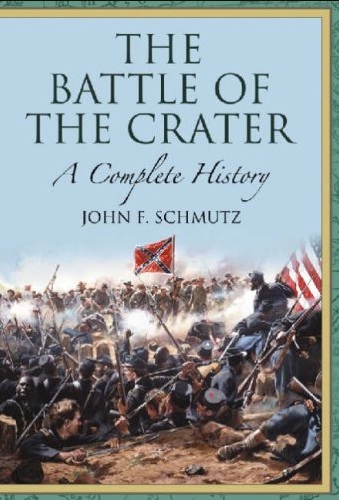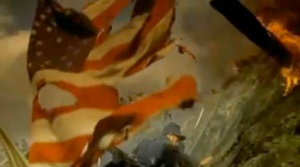Posts Tagged ‘civil war history’
The Battle of the Crater: A Complete History
- Title: The Battle of the Crater: A Complete History
- Author: John F. Schmutz
- Published on: 2009-01-19, McFarland & Company, Inc., Publishers
- Binding: Hardcover
- 428 pages
- ISBN-10: 0786439823
- ISBN-13: 978-078643982
I have happily received a review copy of John F. Schmutz’s The Battle of the Crater: A Complete History. I can be counted among those whose interest in this remarkable 9 hour battle was piqued after watching the mesmerizing opening sequence of the film based on Charles Frazier’s Cold Mountain.
It would be hard to find a similar military event in history that paralleled this one in terms of overwhelming potential for success run amok. Schmutz’s use of an opening quote about the July 30, 1864 battle by Ulysses S. Grant perhaps says it best…
The loss in the disaster of Saturday last foots up about 3,500, of whom 450 men were killed and 2,000 wounded. It was the saddest affair I have ever witnessed in the war. Such an opportunity for carrying fortifications I have never seen and do not expect again to have.
– Lieutenant General Ulysses S. Grant to Major General
Henry W. Halleck, August 1, 1864.
According to Schmutz, his interest in the Battle of the Crater began with the discovery that he had “two direct ancestors in the battle, one with the 14th New York Heavy Artillery, which at the last minute, and without any preparation or forewarning, was chosen to lead the assault, with disastrous consequences.” (Preface) This seed germinated into one of the first studies to take a broad-brush approach to the battle, examining the events leading up to it, the country’s mood in its now third year of civil war, brutality committed against black troops, atrocities perpetrated by both sides, first-hand accounts, and the impact of the battle “on the body politic of both sides.”
Schmutz appropriately gives readers a sense for war in the trenches that were part of the Siege of Petersburg.
As both sides dug even deeper entrenchments and more infantry obstacles, the rolling farmland east and south of the city was soon churned into scenes resembling a moonscape. These tandem ramparts ran for twenty-six miles, crossed two major rivers, and traversed parts of four Virginia countries, from White Oak Swamp, east of Richmond, across Bermuda Hundred and south of the Jerusalem Plank Road below the city. No campaign of the war quite equaled the siege of Petersburg, which was the object of the longest military action ever waged against an American city. More battles were fought and more lives lost there than in the defense of any better-known Southern cities such as Richmond, Vicksburg or Atlanta. (p. 40)
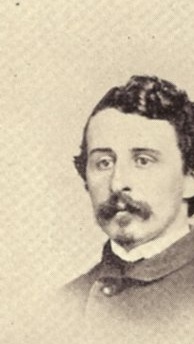
Henry Pleasants
The excellent chapter titled “The Earth Movers,” reveals how Lt. Col. Henry Pleasants and the men of the 48th Pennsylvania, many of them coal miners, accomplished what Meade’s engineers mockingly called impossible, the building of a lengthy tunnel without detection by the Confederates. Receiving literally no support from Meade or his men, Pleasants overcame every challenge with ingenuity and innovation. As an example, he used a combination of miner’s bellows and fire to create draft to circulate air through a shaft built into the tunnel wall. This bit of creative thinking, the details of which are a must read, became what Schmutz called Pleasants’ “greatest engineering feat.” (p. 61)
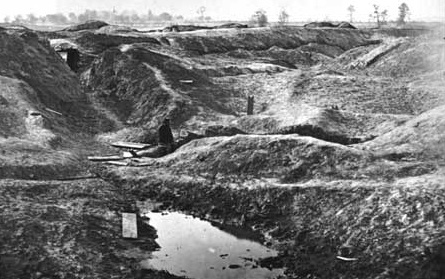
From the National Park Service site on the Petersburg National Battlefield, "The Crater as it appeared in 1865. The Union soldier seated at the end of the tunnel gives an idea of the size of the Crater." Click the image to go to the site.
Of note, Schmutz provides an impressive set of references in his appendices, something I always value in a book of serious history. These include:
- Organization of Opposing Forces on July 30, 1864 including Union and Confederate Corps, Division, and Brigade, and in some cases Company commanders and officers
- Casualty counts by Corps, Division, Brigade and Unit
- Medal of Honor Recipients and Confederate Roll of Honor Recipients by Corps including a brief statement about why they received the award
Union Officers Killed or Mortally Wounded by Corps, Division, and Brigade - Full and extensive Chapter Notes
- An impressive Bibliography which demonstrates the extent of primary sources used in Schumtz’s research
I greatly look forward to fully reading this book and fully expect that a Highly Recommend will be forthcoming.
Kevin Levin has recently provided a review of The Battle of the Crater: A Complete History on H-Net here.
Military History Word of the Day: “Ambuscade”
–
am⋅bus⋅cade
[am-buh-skeyd] noun, verb, -cad⋅ed,
–noun
1. an ambush
–verb (used without object)
2. to lie in ambush.
–verb (used with object)
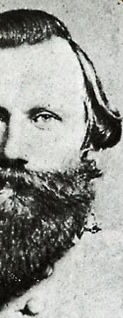
Jeb Stuart
3. to attack from a concealed position; ambush.
1575–85; < MF embuscade, alter. (under influence of OF embuschier) of MF emboscade < OIt imboscata, fem. ptp. of imboscare, v. deriv. with in- of bosco wood, forest < Gmc *bosk- bush
Related forms: am⋅bus⋅cad⋅er, noun [1]
—-
As used by Joseph L. Harsh in Taken at the Flood…
On this occasion, Jeb Stuart justified his reputation for alert reconnaissance. Almost instantaneously he perceived and reported to Lee the enemy’s rapid withdrawal. He also ordered Hampton to pursue and harass the Federal column retiring from Flint Hill toward the Chain Bridge. Into the hours of darkness, Hampton closely pressed the Federal tail under Sedgwick, lobbing shells into the panicky main body until the heavy casualties suffered by the 1st North Carolina Cavalry in an “ambuscade” laid by the 71st Pennsylvania Infantry bought breathing space for the retreating Federals. Meanwhile, in the center of the line, where Stuart had only Fitz Lee’s tired troopers, the Confederate horsemen pressed more gently and permitted Hooker to withdraw through the county seat virtually unscathed. Heros von Borcke, Stuart’s Prussian chief of staff (see his memoir online here), planted the Confederate colors on the courthouse green, while deliriously happy Southern sympathizers mobbed the troopers, and damsels showered Stuart with kisses. Jeb even found time to visit his friend and “spy” Antonia Ford. [2]
—–
[1] ambuscade. Dictionary.com. The American Heritage® Dictionary of the English Language, Fourth Edition. Houghton Mifflin Company, 2004. http://dictionary.reference.com/browse/ambuscade (accessed: July 25, 2009).
[2] Joseph L. Harsh, Taken at the Flood : Robert E. Lee and Confederate Strategy in the Maryland Campaign of 1862 / [book on-line] (Kent, OH: Kent State University Press, 1999, accessed 25 July 2009), 19; available from Questia, http://www.questia.com/PM.qst?a=o&d=102364729; Internet.
More Debate on The State of Jones and Interview with John Stauffer
–
A quick break from the books to tip the hat to Elektra Tig for Tweet on John Stauffer interview here on the Omnivoracious blog about his book, The State of Jones.
The book continues to generate debate.
The Wall Street Journal posted a chapter in their books section here and Michael B. Ballard’s review of the book appears in the WSJ here. Authors Sally Jenkins and John Stauffer provide a response/rebuttal to that review on July 17th in an article titled “The State of Jones Was Real, and Ahead of Its Time” available here. The debate continues to be fascinating.
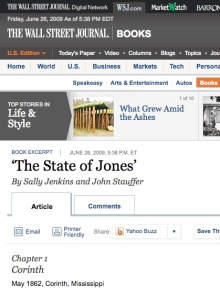
OK back to Taken at the Flood.
Two Brothers: One North, One South
While on vacation, I received a review copy of David H. Jones’ Two Brothers: One North, One South.
This has moved very quickly up to the top of my reading stack for between terms. It is an aesthetically beautiful book. And I’m impressed by the weaving of fact into the story. I’m also hooked by the notion that poet Walt Whitman is the story’s glue. Can’t wait and more to come once I can put my feet up on the porch and enjoy.
By the way, Mr. Jones maintains a website here and a blog here which carries the same title as his book but covers more information. I’m adding it to my blogroll as I rather like the information and really do enjoy following the blogs or historical authors.
Product Details
- Hardcover: 320 pages
- Publisher:Staghorn Press; First edition [February 1, 2008]
- Language: English
- ISBN-10: 0979689856
- ISBN-13: 978-0979689857
- Product Dimensions: 9.1 x 6 x 1.3 inches
- Shipping Weight: 1.2 pounds
Stewards of Civil War Railroads – Part III
This post completes the series, Stewards of Civil War Railroads. Read Part I here and Part II here.

Above: Group of the Construction Corps U.S. Mil. R. Rds., with working tools, etc., Chattanooga, Tennessee
Courtesy of Library of Congress: LC-USZ62-62364
Millett and Maslowski posit that President Abraham Lincoln did not have Jefferson Davis’ sensitivity about government interference with railroads. The evidence supports the point and also suggests that Davis’ hands-off approach expanded to other areas under his purview including signals and communications. Whether he was afflicted with chronic indecisiveness or was bowing to the perceived whims of a public unreceptive to “big government” is open for discussion but as in many things, the truth probably lies somewhere in between. Regardless, it is clear that rational military considerations were not the sole concern in shaping the South’s military policies and programs. Had they been so, military needs would have received higher priority and the events of the war may have flowed differently.
Above: Lincoln and McClellan
The impact of the decision making processes in the Lincoln and Davis administrations and the respective Congresses as regards those issues impacting the military is indeed a fascinating one and worthy of continued analysis and review. Clearly the social, economic, and political nuances of the North versus the South had much to do with the directions taken within each section. But one is left to wonder whether the leadership qualities of Lincoln and Davis, including the ability to be decisive, allowed the North to more frequently follow a path guided by rational military reason.
Above: The engine “Firefly” on a trestle of the Orange and Alexandria Railroad.
American Historian: George Bancroft
I’m back from Christmas break and trying to recuperate from a few too many cinnamon rolls. Reading assignments and preparation of a research proposal due Sunday are top of mind.
The class is Historiography so the research isn’t to be about the development and proof of a thesis. It’s more about research into the history of how history was written.
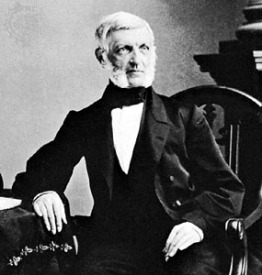 For my research paper, I plan to explore the influence of historian George Bancroft (right) on Antebellum, Civil War, and Postbellum American history. I may need to shave this down a bit depending on how much material I find.
For my research paper, I plan to explore the influence of historian George Bancroft (right) on Antebellum, Civil War, and Postbellum American history. I may need to shave this down a bit depending on how much material I find.
Bancroft was one of the best known American historians of the 19thcentury. While Harvard educated (he entered at 13 and graduated at 17!), he is considered a “literary historian,” who wrote in a style popular with  the public. His primary work was the multi-volume History of the United States from the Discovery of the American Continent, which he began writing in 1830. [Picture left of remaining vHe published the first three volumes over that decade. The final set would be ten volumes. A first revision was completed and published as six volumes in 1876 as part of the national centennial.
the public. His primary work was the multi-volume History of the United States from the Discovery of the American Continent, which he began writing in 1830. [Picture left of remaining vHe published the first three volumes over that decade. The final set would be ten volumes. A first revision was completed and published as six volumes in 1876 as part of the national centennial.
Perhaps less known is that Bancroft, while Secretary of the Navy, created the Naval Academy. He was also chosen by Congress to eulogize Abraham Lincoln. The New York Times reprinted that Eulogy on the occasion of the fiftieth anniversary of the event in 1915. It, along with drawings of the event, can be seen in their entirety here.
I have located the index to his papers housed on microfiche at Cornell University and two biographies which leverage that material. The first, a two volume set 1971 reprint of M.A. DeWolfe Howe’s 1908 work The Life and Letters of George Bancroft, I was able to find on the Amazon Marketplace in almost pristine shape. The second, George Bancroft: Brahmin Rebel, was written by Russel B. Nye and published in 1945. It’s on order. There are other large collections of Bancroft materials in holdings by the Massachusetts Historical Society, the Library of Congress and the New York Public Library. I’m beginning in earnest a search for articles that deal with his contributions to American history as well.
As a follow-up at some later point, I think it would be very interesting to contrast the style and impact 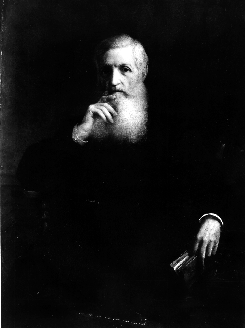 of George Bancroft with Charles and Mary Beard. As a historian friend of mine said, “you’d be hard pressed to find two more different expositors on the American experience than Bancroft and Beard. Bancroft was an unabashed patriot and advocate of democracy, to a degree that would be considered embarrassing in most academic settings today. Still, he was indeed the most articulate and widely-read of our early historians, and his writings both reflected and helped to create the sense of American exceptionalism that has prevailed for most of our history as a nation.”
of George Bancroft with Charles and Mary Beard. As a historian friend of mine said, “you’d be hard pressed to find two more different expositors on the American experience than Bancroft and Beard. Bancroft was an unabashed patriot and advocate of democracy, to a degree that would be considered embarrassing in most academic settings today. Still, he was indeed the most articulate and widely-read of our early historians, and his writings both reflected and helped to create the sense of American exceptionalism that has prevailed for most of our history as a nation.”
You might recall that Charles and Mary Beard were the first to suggest that the Civil War was the second American revolution as was mentioned in my previous post here.
The exceptional oil on canvas portrait above of Bancroft in later life was painted by Gustav Richter, a German painter (1823 – 1884). It is a part of the Harvard University Portrait Collection and is on display at Memorial Hall.
More as I get into my research.
Photo credits:
Photo of George Bancroft in middle age taken by Mathew Brady, courtesy of the Library of Congress.
Photo of painting above: The President and Fellows of Harvard College.
